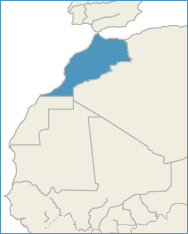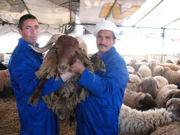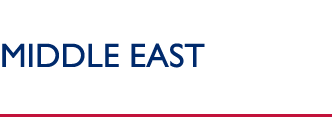 |
|
 |
 |
 |
| USAID Information:
External Links:
|
|
 |
 |
|
 |
 |
|
Morocco

SNAPSHOT
Date of independence: 1956
Population: 30.5 million (2006)
Income per person: $1,900 (yr)
Source: Government of Morocco and World Bank Development Indicators 2007
USAID IN MOROCCO
www.usaid.gov/ma/
CONTACTS
Mission Director
Monica Stein-Olson
American Embassy/Rabat
PSC 74, Box 022
APO AE 09718
Tel: 212-37-63-2010
Morocco Desk Officer
Christophe Tocco
Tel: (202) 712-1282
Email: ctocco@usaid.gov 
A USAID agriculture project helps sheep herders’ cooperatives enhance their sheep production systems, develop market relationships, integrate marketing systems, and upgrade slaughterhouses, with the ultimate goal of strengthening the sheep meat value chain in Morocco’s Oriental region. (Photo: USAID/Morocco 2007) Overview
Morocco is the United States’ oldest friend in the region and is today recognized as a major non-NATO ally. Under the leadership of King Mohammed VI, this stable, moderate Arab nation has launched itself on a path toward democratic participation in governance. Its steady pace is emblematic of a liberalizing nation committed to meeting the needs of its people while recognizing the value of stability in this corner of an unstable region.
Morocco, however, still faces many complex challenges, including persistent unemployment and inadequate access to housing, land, credit, and other productive resources. Poverty and illiteracy remain common, especially among women and female-headed households. Since 1957, the U.S. government and the Government of Morocco have worked together to make real and substantial improvements in the lives of Moroccan citizens. While much work remains to be done, the U.S.-Moroccan partnership has yielded positive results with the mutual goal of building a democratic, well-governed, and economically sound Morocco.
Programs
Economic Growth: Economic Opportunities
USAID’s economic growth programs assist Morocco in successfully responding to the challenges and opportunities of the more-liberalized trading environment resulting from the free trade agreement with the United States, other trade agreements and Morocco’s own reform efforts.
The U.S.-Morocco Free Trade Agreement, which went into effect in 2006, is projected to boost trade and investment. However, Moroccan farmers may face stiff competition in commodities such as wheat and oil seeds when agricultural tariffs are lowered.
To make up for the lost income, USAID works with farmers to shift to higher-value crops and develop jobs in other industries, such as textiles and apparel. USAID assists export-ready businesses to enter the U.S. market successfully. To improve the business climate, USAID programs work to reduce red tape and make it easier for small businesses to access finance, allowing Moroccan private enterprise to take advantage of the new trade opportunities. USAID assistance also has helped to reduce the number of days needed to register a business from 60 to 11.
Investing In People: Education
Morocco has nearly reached its goal of universal access to primary education. Yet, retention remains a major challenge in most parts of the country: the middle school completion rate is only 47 percent. USAID has supported the Ministry of Education’s reforms for the past decade and continues to assist the Ministry in providing high-quality basic education in an effort to reduce the drop-out rate. Another continuing challenge is the high rate of illiteracy, particularly for women, which currently is 47 percent (75 percent in rural areas).
USAID endeavors to improve training opportunities for Moroccan youth and increase access to quality, relevant basic education. USAID uses two approaches to achieve this (1) the basic education approach, which aims to improve retention rates and equip students with portable and adaptable skills upon middle school graduation, and (2) the "school-to-work" approach, which aims to create close connections between training and employment at various post–middle school levels.
For young Moroccans closer to the job market, USAID focuses on training - especially in information technology and life skills - and on building job connections to prepare youth for the workforce. This includes training in agriculture for students in technical institutes.
Governing Justly and Democratically
Since the early 1990s, Morocco has made substantial progress in extending and implementing democratization and good governance reforms. In recent years, Morocco has witnessed a rejuvenation of the governing role of its political parties and representative bodies and has focused considerable attention on empowering local-level actors through increased devolution of authority and decentralization of decision-making. Governance reforms and the emergence of citizen voices at various levels present strong opportunities for national and sub-national elected bodies to advance their democratic and good governance functions.
USAID strives to support this progress by promoting a transparent system of governance that encourages public debate, by supporting projects to improve leadership within municipal structures, and by developing partnerships between citizens and government to deliver tangible results, especially at the local level.
Back to Top ^
|


